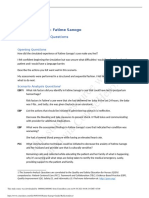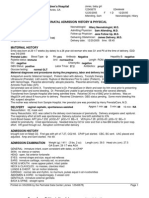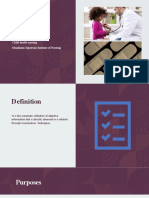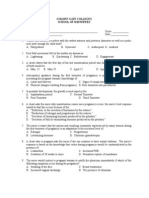Physical Assessment: Assessment Procedure Normal Findings Abnormal Findings
Physical Assessment: Assessment Procedure Normal Findings Abnormal Findings
Uploaded by
Josal SinonCopyright:
Available Formats
Physical Assessment: Assessment Procedure Normal Findings Abnormal Findings
Physical Assessment: Assessment Procedure Normal Findings Abnormal Findings
Uploaded by
Josal SinonOriginal Description:
Original Title
Copyright
Available Formats
Share this document
Did you find this document useful?
Is this content inappropriate?
Copyright:
Available Formats
Physical Assessment: Assessment Procedure Normal Findings Abnormal Findings
Physical Assessment: Assessment Procedure Normal Findings Abnormal Findings
Uploaded by
Josal SinonCopyright:
Available Formats
ST.
FERDINAND COLLEGE
COLLEGE OF HEALTH SCIENCES
Sta. Ana, Ilagan 3300, Isabela
Tel. No. (078) 622-3110
CHS is a holistic department with dynamic staff who intend to produce globally competitive health care provider
Physical Assessment
Assessment Procedure Normal Findings Abnormal Findings
GENERAL IMPRESSION
Observe physical and sexual
development
Appropriate for gender and age Delayed puberty
Compare clients stated age with her
apparent age and developmental age
Client appear to be her stated
chronologic age
Appears older than actual chronologic
age
Observe skin condition and color Color is even without obvious
lesions
Extreme pallor, flushed, or yellow in
light skinned
Observe hygiene Clean and groomed appropriately
for occasion
Dirty, unkempt appearance with a foul
body odor
Observe posture and gait Posture is erect and comfortable
for age. Gait is coordinated.
Curvature of the spine
Observe behavior, body movement Cooperative and purposeful in
his interaction with others
Uncooperatively behavior
Observe facial expression Facial features are symmetric
with movement
Poor eye contact is seen in depressed
clients
Listen to speech Speech is clear Disorganized
HEAD
Inspect the head (size and shape) Head is symmetric round, erect,
and in midline. No lesions are
visible.
The skull and facial bones are larger
and thicker
Inspect for involuntary movement Head should be held still and
upright
Tremors
Palpate the head Normally hard and smooth
without lesions
With lesions, lumps on the head may
indicate recent trauma or cancer
Inspect the face for symmetry features,
movement, expression and skin
condition
Face is symmetric with round,
elongated or square appearance
Asymmetry
Palpate the temporal artery The temporal artery is elastic and
not tender
Hard, thick and tender
NECK
Inspect the neck(position, symmetry,
lumps or masses)
Symmetric Swelling, enlarged mass
Inspect movement of the neck. Ask the
client to swallow a small sip of water
The thyroid gland move upward
symmetrically
Asymmetric movement
Inspect the cervical vertebra. Ask the
client to flex the neck, chin to chest,
ear to shoulder
C7 is usually visible and
palpable. In older client cervical
curvature may increase.
Prominence or swelling other than the
C7 vertebra
Inspect range of motion Neck movement should be
smooth and controlled with 45
degree flexion
Muscles spasm or inflammation
Palpate the trachea Trachea should be at the midline Thyroid gland enlargement, tumor
Palpate the thyroid gland Landmarks are positioned
midline
Presence of masses
EYES
Test distant visual acuity Normal distant visual acuity is
20/20
Mayopia(impaired far vision)
Test near visual acuity Normal near visual acuity is
14/14
Presbyopia (impaired near vision)
Perform corneal light reflex test. Hold
penlight 12 inches from the clients face
The reflection of light of the
cornea should be on the exact
same spot on each eye which
indicates parallel alignment
Asymmetric position of the light reflex,
this may be due to muscle weakness or
paralysis
Perform cover test The uncovered eye should
remain fixed straight ahead
The uncovered eye will move to
established focus when the opposite
eye is covered.
EARS
Inspect the auricle and lobule. Ears are equal in size bilaterally
(4 to 10 cm)
Ears are smaller than 4 cm or longer
than 10 cm
Inspect the tympanic
membrane(eardrum)
Tympanic membrane should be
pearly, gray, shiny
Red, bulging eardrum
Perform webers test if the client
reports diminished or lost hearing in
one ear
Vibrations are heard equally well
in both ears.
With conductive hearing loss.
Perform the Rinne test. Air conduction sound is normally
heard longer than bone
conduction sound
With conductive hearing loss.
MOUTH
Inspect the lips Lips are smooth and moist Pallor around the lips
Inspect the teeth and gums 32 pearly whitish teeth Brownies or yellow with dental carries
Inspect the vocal mucosa Appear pink in light-skinned
clients
Leukoplakia may be seen in chronic
irritation and smoking
Observe the sides of the tongue No lesions, ulcers or nodules Canker sores maybe seen on the sides
of the tongue in clients receiving
certain kinds of chemotherapy.
Inspect the tonsils Tonsils maybe present or absent.
Normally pink and symmetric.
Red enlarged
NOSE
Inspect and palpate the external nose. Color is the same as the rest of
the face
Nasal tenderness on palpation
Inspect the internal nose The nasal mucosa is dark pink,
moist and free of exudates
Nasal mucosa is swollen and pale
Inspect for nasal flaring Nasal flaring is not observe Nasal flaring is seen with labored
respirations
POSTERIOR THORAX
Palpate for tenderness and sensation Client reports no tenderness, pain Tender or painful areas
Palpate for crepitus(like bones or hairs
rubbing each other)
The examiner finds no palpable
crepitus
Crepitus can be palpated if air escapes
from the lungs
Palpate for fremitus Fremitus is symmetric and easily
identified in the upper regions of
the lungs
Unequal fremitus is usually the result
of bronchial obstruction
Percuss for tone. Start at at the apices
of the spatula and percuss across the
top of both shoulders.
Resonance is the percussion tone
elicited over normal lung tissue.
Hyperresonance is elicited in case of
trapped air such as in emphysema or
pneumothorax. Dullness is present
when fluid or solid tissue replaces air
in the lung or occupies the pleural
space such as in lobar pneumonia,
pleural effusion, or tumor.
Percuss for diaphragmatic excursion.
Ask the client to exhale forcefully and
hold the breath. Beginning at the
scapular line (T7)
Excursion should be equal
bilaterally and measure 3 to 5 cm
in adults
Diaphragmatic descent may be limited
by atelectasis of the lower lobes or by
emphysema
Assess chest expansion. Place your
hands on the posterior chest wall with
your thumbs at the level of T9 or T10
and pressing together a small skin fold.
When the client takes a deep
breath, the examiner thumb
should move 5 to 10cm apart
symmetrically.
Unequal chest expansion
Auscultate for breath sounds Three types of normal breath
sounds bronchial,
bronchovesicular, vesicular
sound
Absent breath sounds
ANTERIOR THORAX
Inspect for shape and configuration The anteroposterior diameter is
less than the transverse diameter
Anteroposterior equals transverse
diameter resulting in barrel chest
Inspect position of the sternum Sternum is positioned at midline Pectus excavatum or sunken sternum
and straight open referred to as funnel chest
Observed quality and pattern of
respiration
Respiration are relaxed,
effortless, and quiet
Labored and noisy breathing
Inspect intercostals spaces No retractions or bulging Retraction of the intercostals spaces
indicates an increase inspiratory effort
Palpate anterior chest expansion Thumbs move outward in a
symmetric fashion from the
midline
Unequal chest expansion
BREAST
Inspect size and symmetry Breast can be a variety of sizes.
One breast may normally be
larger than the other.
Increase in the size of one breast may
indicate inflammation or abnormal
growth.
Inspect the areolas Areolas vary from dark pink to
dark brown
Peau dorange skin, associated with
cancer
Inspect the nipples Nipples are nearly equal
bilaterally in size
A recently retracted nipple that was
previously everted suggest malignancy
Palpate texture and elasticity It should be smooth, firm, elastic
tissue.
Thickening of the tissues
Palpate for masses No masses should be palpated Malignancy tumors
Inspect and palpate the axillae No rash or infection noted With masses
HEART(Precordium)
Inspect pulsation The apical impulse may or may
not be visible
Pulsations is noted
Auscultate for murmurs Normally no murmurs are heard Pathologic midsystolic, and diastolic
murmurs
ARMS
Observed arm size and venours pattern;
also look for edema
Arms are bilaterally symmetric Presence of edema
Observed coloration of the hands Color varies depending on the
clients skin tone
Reynouds disease, a vascular disease
caused by vasoconstriction
Palpate to assess capillary refill time Capillary beds refill returns in 1
to 2 seconds
Capillary refill time exceeding 2
seconds
ABDOMEN
Observe the coloration of the skin Abdominal skin may be paler
than the general skin tone
because this skin is so seldom
exposed to the natural elements
Purple discoloration at the flanks
indicates bleeding within the
abdominal wall, possibly from trauma
to the kidneys, pancreas or duodenum
or from pancreatitis
Note the vascularity of the abdominal
skin
Scattered fine veins may be
visible
Dilated veins may be seen with
cirrhosis of the liver, obstruction of the
inferior vena cava, portal hypertension,
or ascites
Note any striae Old, silvery, white striae or
stretch marks from past
pregnancies or weight gain are
normal
Dark bluish-pink striae are associated
with Cushings syndrome
Inspect for scars. Ask about the source
of a scar, and use a centimeter ruler to
measure the scars length
Pale, smooth, minimally raised
old scars may be seen
Non healing scars, redness,
inflammation
Assess for lesions and rashes Abdomen is free of lesions or
rashes
Changes in moles including size, color
and border symmetry
Inspect the umbilicus. Note the color of
the umbilical area
Umbilical skin tones are similar
to surrounding abdominal skin
tones or even pinkish
Bluish or purple discoloration around
the umbilicus (Cullens sign) indicates
intra-abdominal bleeding
Observe umbilical location Umbilicus is midline and lateral
line
A deviated umbilicus may be caused
by pressure from a mass, enlarges
organs, hernia, fluid, or scar tissue
Assess contour of umbilicus It is recessed (inverted) or
protruding no more than 0.5 cm
and is round or conical
An everted umbilicus is seen with
abdominal distention
Inspect abdominal contour. Look Abdomen is flat, rounded, or A generalized protuberant or distended
across the abdomen at eye level from
the clients side, from behind the clients
head , and from the foot of the bed.
Measure abdominal girth as indicated
scaphoid (usually seen in thin
adults)
abdomen may be due to obesity, air, or
fluid accumulation.
Assess abdominal symmetry. Abdomen is symmetric Asymmetry may be seen with organ
enlargement, large masses, hernia,
diastasis recti, or bowel obstruction
Inspect abdominal movement when the
client breathes
Abdominal respiratory
movement may be seen,
especially in male clients
Diminished abdominal respiration or
change to thoracic breathing in male
client may reflect peritoneal irritation
Observe aortic pulsations A slight pulsation of the
abdominal aorta, which is visible
in the epigastrium, extends full
length in thin people
Vigorous, wide, exaggerated pulsations
may be seen with abdominal aortic
aneurysm
Observe for peristaltic waves Normally peresitaltic waves are
not seen although they may b e
visible in very thin people as
slight ripples on the abdominal
wall
Peristaltic waves are increased and
progress in a ripple-like fashion from
the LUQ to the RLQ with intestinal
obstruction
Auscultate for bowel sounds. Use the
diaphragm of the stethoscope and make
sure that it is warm before you place it
on the clients abdomen
A series of intermittent, soft
clicks and gurgles are heard at a
rate of 5 to 30 per minute
Hypoactive bowel sounds indicate
diminished bowel motility. Common
caused include abdominal surgery or
late bowel obstruction.
Auscultate for vascular sounds Bruits are not normally heard
over abdominal aorta or renal,
iliac, or femoral arteries.
A bruit with both systolic and diastolic
components occurs when blood flow in
an artery is turbulent or obstructed.
Auscultate for a friction rub over the
liver and spleen
No friction rub over liver or
spleen is present
Friction rubs are rare.
Percuss for tone. Lightly and
systematically percuss all quadrants.
Generalized tympany
predominates over the abdomen
because of air in the stomach and
intestines.
An enlarged area of dullness is heard
over an enlarged liver or spleen.
Percuss the span or height of the liver
by determining its lower and upper
borders
The lower border of liver
dullness is located at the costal
margin to 1 to 2 cm below
The upper border of liver dullness may
be difficult to estimate if obscured by
pleural fluid or lung consolidation
Percuss the spleen The spleen is an oval area of
dullness approximately 7 cm
wide near the left tenth rib and
slightly posterior to the MAL
Splenomegaly is characterized by an
area of dullness greater than 7 cm
wide.
LEGS
Inspect for lesions or ulcers Legs are free of lesions or
ulcerations
With ulcers
Inspect for edema Identical size and shape
bilaterally no swelling or atrophy
With bilaterally edema
You might also like
- TUTORÍASDocument116 pagesTUTORÍASAdolfo Cortés Córdoba100% (1)
- Complete Head-To-Toe Physical Assessment Cheat SheetDocument8 pagesComplete Head-To-Toe Physical Assessment Cheat SheetjthsNo ratings yet
- This Study Resource Was: Maternity Case 5: Fatime SanogoDocument2 pagesThis Study Resource Was: Maternity Case 5: Fatime SanogoNicole Angel100% (1)
- Small Bowel Obstruction System - DisorderDocument1 pageSmall Bowel Obstruction System - DisorderMarina Wasem Netzlaff0% (1)
- Clinical Teaching Plan DRDocument4 pagesClinical Teaching Plan DRJosal Sinon100% (11)
- Steven McGee-Evidence-Based Physical Diagnosis-Elsevier (2017) - CompressedDocument6 pagesSteven McGee-Evidence-Based Physical Diagnosis-Elsevier (2017) - CompressedCristian Kamilo Kiroga50% (2)
- Heent ScriptDocument4 pagesHeent ScriptJohn TecsonNo ratings yet
- Complete Head-to-Toe Physical Assessment Cheat Sheet - NurseslabsDocument9 pagesComplete Head-to-Toe Physical Assessment Cheat Sheet - NurseslabsJC QuinNo ratings yet
- Physical AssessmentDocument19 pagesPhysical Assessmentsilentscream0618No ratings yet
- Labor and Delivery AssessmentDocument16 pagesLabor and Delivery AssessmentLizaEllaga100% (1)
- Head To Toe Assessment in 5 MinutesDocument30 pagesHead To Toe Assessment in 5 Minutesdabyers8150No ratings yet
- Pediatric Assessment (1 - 12)Document11 pagesPediatric Assessment (1 - 12)Rose Ann Salanap80% (5)
- Newborn AssessmentDocument3 pagesNewborn AssessmentValerie Ybañez Peñalber100% (2)
- Ob AbbreviationDocument2 pagesOb AbbreviationwenwenwencheatNo ratings yet
- Quiz #2 Fluid MechanicsDocument2 pagesQuiz #2 Fluid MechanicsJosal SinonNo ratings yet
- Key To The UK Species of BembidionDocument54 pagesKey To The UK Species of BembidionwilhelmNo ratings yet
- Minor Ailments During PregnancyDocument47 pagesMinor Ailments During PregnancyDiablo Goliath0% (1)
- Shine, A Publication of Texas Children's HospitalDocument24 pagesShine, A Publication of Texas Children's HospitalShannon RaspNo ratings yet
- All About PragnancyDocument29 pagesAll About PragnancyBaalu KathirveluNo ratings yet
- Health AssessmentDocument17 pagesHealth Assessmentchenyl27100% (2)
- General Appearance: Ital SignDocument4 pagesGeneral Appearance: Ital SignLiza Estrabo100% (1)
- Screening Head To Toe Physical ExaminationDocument16 pagesScreening Head To Toe Physical ExaminationJay Mar Mendoza BabateNo ratings yet
- Conduct of Physical Examination: I. General SurveyDocument10 pagesConduct of Physical Examination: I. General SurveyWeng RamojalNo ratings yet
- Head To Toe AssessmentDocument2 pagesHead To Toe AssessmentMichelle Myca Rosauro100% (1)
- Head To Toe Physical AssessmentDocument9 pagesHead To Toe Physical Assessmentthe studentNo ratings yet
- Complete Head-To-Toe Physical Assessment Cheat SheetDocument7 pagesComplete Head-To-Toe Physical Assessment Cheat SheetA C100% (1)
- Adult Physical AssessmentDocument18 pagesAdult Physical AssessmentHa HahahahahaNo ratings yet
- Physical Assessment CheatDocument7 pagesPhysical Assessment CheatJepe Urate100% (1)
- Nursing Care Plan Placenta PreviaDocument2 pagesNursing Care Plan Placenta PreviaApril Ann HortilanoNo ratings yet
- Head To Toe Assessment BagusDocument2 pagesHead To Toe Assessment BagussyahrudiNo ratings yet
- Physical Assessment Ears, Eyes, Nose, Throat and Cranial NervesDocument28 pagesPhysical Assessment Ears, Eyes, Nose, Throat and Cranial Nervesjennylyn guadalupeNo ratings yet
- List of Pathology Mnemonics - WikipediaDocument10 pagesList of Pathology Mnemonics - WikipediaAmir ShedNo ratings yet
- Head To Toe Checklist (Masroni)Document13 pagesHead To Toe Checklist (Masroni)hillary elsaNo ratings yet
- Physical Assessment: Lecturer: Mark Fredderick R. Abejo R.N, M.A.NDocument20 pagesPhysical Assessment: Lecturer: Mark Fredderick R. Abejo R.N, M.A.NRyan Biwit100% (4)
- History and Physical Exam Skills List: Opening VisitDocument7 pagesHistory and Physical Exam Skills List: Opening VisitAnonymous Sfcml4GvZNo ratings yet
- Head-To-Toe Checklist: Beautiful Nursing LLCDocument4 pagesHead-To-Toe Checklist: Beautiful Nursing LLCcarlyNo ratings yet
- Head To Toe Physical AssessmentDocument6 pagesHead To Toe Physical AssessmentGarrett BatangNo ratings yet
- Parts To Be Assessed Technique Normal Findings Actual Findings Remarks Interpretation General AppearanceDocument8 pagesParts To Be Assessed Technique Normal Findings Actual Findings Remarks Interpretation General AppearanceJulius Balingit100% (2)
- NANDA Nursing DiagnosisDocument6 pagesNANDA Nursing DiagnosisAlex HanNo ratings yet
- Head To Toe Assessment Guide PDFDocument6 pagesHead To Toe Assessment Guide PDFTashaNo ratings yet
- Nursing Care Plan PDFDocument6 pagesNursing Care Plan PDFEngely MercaderNo ratings yet
- Focused AssessmentDocument3 pagesFocused Assessmentisapatrick8126No ratings yet
- Complete Head To Toe AssessmentDocument11 pagesComplete Head To Toe AssessmentKathleen Daban Ragudo100% (1)
- Ipd B: Finals - Heent: Techniques of Examination For Head (From Bates')Document13 pagesIpd B: Finals - Heent: Techniques of Examination For Head (From Bates')Janica Marie Ragsac100% (2)
- History & Physical Diagnostic#Document106 pagesHistory & Physical Diagnostic#Olsa Alshapira100% (1)
- Neonatal Assessmnt Tool PDFDocument2 pagesNeonatal Assessmnt Tool PDFYestin Reece Corpus ArcegaNo ratings yet
- Review of Systems For Current Health Problems (Health Assessment)Document5 pagesReview of Systems For Current Health Problems (Health Assessment)younggirldavid100% (1)
- Case Study 114: ScenarioDocument4 pagesCase Study 114: ScenarioPrincess Levie CenizaNo ratings yet
- Antenatal Assessment 18Document13 pagesAntenatal Assessment 18naga mani100% (1)
- Meningitis-Malaria E PDFDocument44 pagesMeningitis-Malaria E PDFSana ShafeeqNo ratings yet
- Hesi 2024 Exam v1Document60 pagesHesi 2024 Exam v1Pesh B NimmoNo ratings yet
- Neonatal History and Physical ExamDocument2 pagesNeonatal History and Physical ExamMuhammad Farhan Khaliq100% (1)
- Lab Normal Value S&Sof S&Sof : Loma Linda University School of Nursing Accepted Lab Values Adapted From KaplanDocument3 pagesLab Normal Value S&Sof S&Sof : Loma Linda University School of Nursing Accepted Lab Values Adapted From KaplanGiacen100% (3)
- Clinical Skill ScriptDocument12 pagesClinical Skill Scriptannoying fuckerNo ratings yet
- Assessment and Management of Patients With Hearing and Balance Disorders WebDocument36 pagesAssessment and Management of Patients With Hearing and Balance Disorders WebStephKirstin Velasco Malapit100% (2)
- Physical Examination: Binal Joshi Assistant Professor Child Health Nursing Manikaka Topawala Institute of NursingDocument101 pagesPhysical Examination: Binal Joshi Assistant Professor Child Health Nursing Manikaka Topawala Institute of NursingBinal JoshiNo ratings yet
- Physical Examination of The NewbornDocument70 pagesPhysical Examination of The NewbornBeaflor Javier CaldozoNo ratings yet
- Review of SystemsDocument2 pagesReview of SystemsMark Angelo Picar AbelleraNo ratings yet
- Physical AssessmentDocument3 pagesPhysical AssessmentEjie Boy IsagaNo ratings yet
- Medical Review of Systems: General, Constitutional Heart and Cardiovascular Hematologic/LymphaticDocument1 pageMedical Review of Systems: General, Constitutional Heart and Cardiovascular Hematologic/LymphaticBola S-SNo ratings yet
- Medication Classes Cheat SheetDocument2 pagesMedication Classes Cheat SheetJoax Wayne SanchezNo ratings yet
- PEDIATRIC NURSING HandoutDocument17 pagesPEDIATRIC NURSING HandoutJen Ezel100% (1)
- Head To Toe AssessmentDocument7 pagesHead To Toe AssessmentNoslaidysNo ratings yet
- Ventricular Septal Defect, A Simple Guide To The Condition, Treatment And Related ConditionsFrom EverandVentricular Septal Defect, A Simple Guide To The Condition, Treatment And Related ConditionsNo ratings yet
- COMPREHENSIVE NURSING ACHIEVEMENT TEST (RN): Passbooks Study GuideFrom EverandCOMPREHENSIVE NURSING ACHIEVEMENT TEST (RN): Passbooks Study GuideNo ratings yet
- Nursing Mnemonics: The Ultimate Tips and Notes For NursesFrom EverandNursing Mnemonics: The Ultimate Tips and Notes For NursesRating: 5 out of 5 stars5/5 (1)
- First QuizDocument3 pagesFirst QuizJosal SinonNo ratings yet
- Nursing ProcessDocument5 pagesNursing ProcessJosal SinonNo ratings yet
- Health AssessmentDocument4 pagesHealth AssessmentJosal SinonNo ratings yet
- Subsurface Water PresentationDocument90 pagesSubsurface Water PresentationJosal Sinon100% (2)
- Study HardDocument1 pageStudy HardJosal SinonNo ratings yet
- Embankment DamsDocument19 pagesEmbankment DamsJosal Sinon100% (1)
- Physiological and Psychological Changes During PregnancyDocument3 pagesPhysiological and Psychological Changes During Pregnancykimglaidyl bontuyanNo ratings yet
- Obstric History Taking, CasesDocument151 pagesObstric History Taking, CasesljilffbNo ratings yet
- OB Williams Chap 2 Maternal PhysiologyDocument9 pagesOB Williams Chap 2 Maternal PhysiologyRem Alfelor100% (2)
- Wrinkle DissolveDocument2 pagesWrinkle DissolveAaron WeintraubNo ratings yet
- Icoone Beauty Way ENDocument11 pagesIcoone Beauty Way ENIVYNo ratings yet
- Physical Assessment of Normal Pregnant ClientDocument24 pagesPhysical Assessment of Normal Pregnant ClientGhilah MaeNo ratings yet
- The Physiology of The SkinDocument39 pagesThe Physiology of The SkinElvisNo ratings yet
- DR Grand CaseDocument55 pagesDR Grand CaseMaria Michaela CassiopeiaNo ratings yet
- Gotu Kola Benefits in BodybuildingDocument3 pagesGotu Kola Benefits in BodybuildingMichaelNo ratings yet
- Physiological Changes During Pregnancy 2-1Document32 pagesPhysiological Changes During Pregnancy 2-1PATRICK ROSHAN ANo ratings yet
- 2018 Lasers in Surgery and MedicineDocument9 pages2018 Lasers in Surgery and MedicineSvetlanaNo ratings yet
- Exam Mdwifery 101Document3 pagesExam Mdwifery 101invictus044688% (16)
- 2018 Global Consensus Guidelines For The Injection of Diluted and Hyperdiluted Calcium Hydroxylapatite For Skin TighteningDocument10 pages2018 Global Consensus Guidelines For The Injection of Diluted and Hyperdiluted Calcium Hydroxylapatite For Skin Tighteningletty3gapeNo ratings yet
- Quiz MCN Lec MidtermsDocument5 pagesQuiz MCN Lec MidtermsAaron Jane GalangNo ratings yet
- HOW TO USE REMIH PRODUCTS Updated PDFDocument24 pagesHOW TO USE REMIH PRODUCTS Updated PDFLydie OndouaNo ratings yet
- Skin Diseases in Pregnancy: by by Ahmed Elbohoty MD, MRCOG Lecturer of Obstetrics and Gynecology Ain Shams UniversityDocument63 pagesSkin Diseases in Pregnancy: by by Ahmed Elbohoty MD, MRCOG Lecturer of Obstetrics and Gynecology Ain Shams UniversityAhmed Bassett100% (1)
- Beeswax - 15 Amazing Benefits of Beeswax For Skin Care & Skin HealthDocument8 pagesBeeswax - 15 Amazing Benefits of Beeswax For Skin Care & Skin HealthInspire NationsNo ratings yet
- Wholesale Dr. Stretch Marks Oil Use Microneedling Import Removal Stretch Marks New Project For Beauty Salon Effective Stretch Ma PDFDocument1 pageWholesale Dr. Stretch Marks Oil Use Microneedling Import Removal Stretch Marks New Project For Beauty Salon Effective Stretch Ma PDFGlen EstrellaNo ratings yet
- Normal PregnancyDocument114 pagesNormal PregnancyBoruuf If GammachuuNo ratings yet
- How To Lose 8 Kgs Weight in 7 Days - My Health TipsDocument19 pagesHow To Lose 8 Kgs Weight in 7 Days - My Health TipsJon P CoNo ratings yet
- Stretch Mark PowerpointDocument14 pagesStretch Mark Powerpointdhaval88No ratings yet
- Antenatal CareDocument29 pagesAntenatal CareFelaih Binasoy Dela Cruz100% (2)
- Manjistha - ReferenceDocument6 pagesManjistha - ReferenceDrMansi Yeragi SabnisNo ratings yet
- Assessment of The AbdomenDocument186 pagesAssessment of The AbdomenFaith madayag100% (1)

































































































